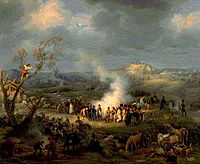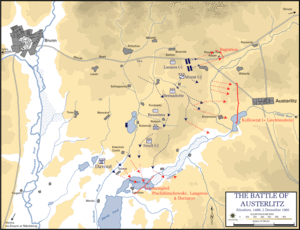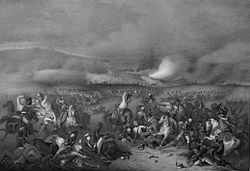
Battle of Austerlitz
Background to the schools Wikipedia
SOS Children offer a complete download of this selection for schools for use on schools intranets. SOS Children works in 45 African countries; can you help a child in Africa?
| Battle of Austerlitz | |||||||
|---|---|---|---|---|---|---|---|
| Part of the War of the Third Coalition | |||||||
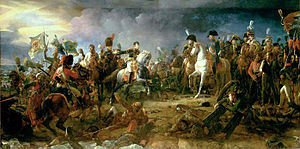 Napoléon at the Battle of Austerlitz, by François Gérard. |
|||||||
|
|||||||
| Belligerents | |||||||
| Commanders and leaders | |||||||
| Napoleon I | Alexander I Francis II |
||||||
| Strength | |||||||
| 65,000-75,000 | 73,000-85,000 | ||||||
| Casualties and losses | |||||||
| 1,305 dead, 6,940 wounded, 573 captured, 1 standard lost |
15,000 dead or wounded, 12,000 captured, 180 guns lost, 50 standards lost |
||||||
|
|||||
The Battle of Austerlitz ( Czech: Bitva u Slavkova) also known as the Battle of the Three Emperors, was one of Napoleon's greatest victories, effectively destroying the Third Coalition against the French Empire. On December 2 1805 ( November 20, Old Style), a French army, commanded by Emperor Napoleon I, decisively defeated a Russo- Austrian army, commanded by Tsar Alexander I, after nearly nine hours of difficult fighting. The battle took place near Austerlitz (Slavkov u Brna) about 10 km (6 miles) south-east of Brno in Moravia. The battle is often regarded as a tactical masterpiece.
The French victory at Austerlitz effectively brought the Third Coalition to an end. On December 26 1805, Austria and France signed the Treaty of Pressburg, which took Austria out of the war, reinforced the earlier treaties of Campo Formio and Lunéville, made Austria cede land to Napoleon's German allies, and imposed an indemnity of 40 million francs on the defeated Habsburgs. Russian troops were allowed to head back to home soil. Victory at Austerlitz also permitted the creation of the Confederation of the Rhine, a collection of German states intended as a buffer zone between France and the rest of Europe. In 1806, the Holy Roman Empire ceased to exist when Holy Roman Emperor Francis II kept Francis I of Austria as his only official title. These achievements, however, did not establish a lasting peace on the continent. Prussian worries about growing French influence in Central Europe sparked the War of the Fourth Coalition in 1806.
Prologue
Europe had been in turmoil since the start of the French Revolutionary Wars in 1792. In 1797, after five years of war, the French Republic subdued the First Coalition. A Second Coalition was formed in 1798, but by 1801, this too was defeated, leaving Britain the only opponent of the new French Consulate. In March 1802, France and Britain agreed to end hostilities under the Treaty of Amiens. For the first time in ten years, all of Europe was at peace. However, many problems persisted between the two sides, making implementation of the treaty increasingly difficult. The British government resented having to turn over most of the colonial conquests it had made since 1793. Napoleon was angry that British troops had not evacuated the island of Malta. The tense situation only worsened when Napoleon sent an expeditionary force to crush the Haitian Revolution. In May 1803, Britain declared war on France.
The Third Coalition
In December 1804, an Anglo-Swedish agreement led to the creation of the Third Coalition. British Prime Minister William Pitt spent 1804 and 1805 in a flurry of diplomatic activity geared towards forming a new coalition against France. Mutual suspicion between the British and the Russians eased in the face of several French political mistakes, and by April 1805, Britain and Russia had signed a treaty of alliance. Having been defeated twice in recent memory by France, and being keen on revenge, Austria joined the coalition a few months later.
La Grande Armée
Prior to the formation of the Third Coalition, Napoleon had assembled an invasion force called the Army of England around six camps at Boulogne in Northern France. He intended to use this invasion force to strike at England, and was so confident of success that he had commemorative medals struck to celebrate the conquest of the English. Although they never set foot on British soil, Napoleon's troops received careful and invaluable training for any possible military operation. Boredom among the troops occasionally set in, but Napoleon paid many visits and conducted lavish parades in order to boost morale.
The men at Boulogne formed the core for what Napoleon would later call La Grande Armée (English: The Great Army). At the start, this French army had about 200,000 men organized into seven corps, which were large field units that contained 36 to 40 cannon each and were capable of independent action until other corps could come to the rescue. A single corps (properly situated in a strong defensive position) could survive at least a day without support, giving the Grande Armée countless strategic and tactical options on every campaign. On top of these forces, Napoleon created a cavalry reserve of 22,000 organized into two cuirassier divisions, four mounted dragoon divisions, and two divisions of dismounted dragoons and light cavalry, all supported by 24 artillery pieces. By 1805, the Grande Armée had grown to a force of 350,000 men, who were well equipped, well trained, and led by competent officers.
Russian army
The Russian army in 1805 had many characteristics of Ancien Régime organization: there was no permanent formation above the regimental level, senior officers were largely recruited from aristocratic circles (and commissions were generally sold to the highest bidder, regardless of competence); and the Russian soldier, in line with 18th-century practice, was regularly beaten and punished "to instill discipline". Furthermore, many lower-level officers were poorly trained and had difficulty getting their men to perform the sometimes complex maneuvers required in a battle. Nevertheless, the Russians did have a fine artillery arm, manned by soldiers who regularly fought hard to prevent their pieces from falling into enemy hands.
The supply system of the Russian Imperial Army was highly dependent on the local population and Russia's Austrian allies. Seventy percent of Russian supplies were provided by Austria. Without a sturdy and organized supply system and with overextended supply lines, the Russian soldiers found it difficult to maintain combat readiness and good health.
Austrian army
Archduke Charles, brother of the Austrian Emperor, had started to reform the Austrian army in 1801 by taking away power from the Hofkriegsrat, the military/political council responsible for decision-making in the Austrian armed forces. Charles was Austria's best field commander, but he was unpopular with the royal court and lost much influence when, against his advice, Austria decided to go to war with France. Karl Mack became the new main commander in Austria's army, instituting on the infantry, on the eve of war, reforms that called for a regiment to be composed of four battalions of four companies, rather than the older three battalions of six companies. The sudden change came with no corresponding officer training, and as a result these new units were not led so well as they could have been. The Austrian cavalry was regarded as the best cavalry in Europe, but the detachment of many cavalry units to various infantry formations reduced its effectiveness against its massed French counterpart.
Preliminary moves
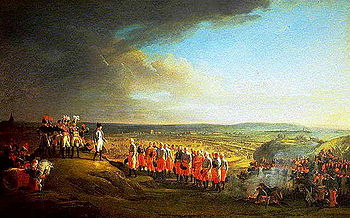
In August 1805, Napoleon, Emperor of the French since May of the previous year, turned his army's sights from the English Channel to the Rhine in order to deal with the new Austrian and Russian threats. On September 25, after great secrecy and feverish marching, 200,000 French troops began to cross the Rhine on a front of 260 km (160 miles). Mack had gathered the greater part of the Austrian army at the fortress of Ulm in Bavaria. Napoleon hoped to swing his forces northward and perform a wheeling movement that would find the French at the Austrian rear. The Ulm Maneuver was well-executed and on October 20 Mack and 23,000 Austrian troops surrendered at Ulm, bringing the total number of Austrian prisoners in the campaign to 60,000. Although the spectacular victory was soured by the defeat of the Franco-Spanish fleet at the Battle of Trafalgar the following day, French success on land continued as Vienna fell in November, replete with 100,000 muskets, 500 cannon, and the intact bridges across the Danube.
Meanwhile, the lateness of the arrival of Russian troops under Kutuzov prevented them from saving the Austrian field armies, so the Russians withdrew to the northeast to await reinforcements and to link up with surviving Austrian units. The French followed, but soon found themselves in an unenviable disposition: Prussian intentions were unknown and could be hostile, the Russian and Austrian armies now converged, and to add to the frustration, Napoleon's lines of communication were extremely long and required strong garrisons to keep them open. Napoleon realized that the only meaningful way to capitalize on the success at Ulm was to force the Allies to battle and defeat them. Fortunately for him, the Russian Tsar was eager to fight.
Battle
Napoleon could muster some 75,000 men and 157 guns for the impending battle, but about 7,000 troops under Davout were still far to the south in the direction of Vienna. The Allies had about 73,000 soldiers, seventy percent of them Russian, and 318 guns.
Battlefield
The northern part of the battlefield was dominated by the 700-foot (210 m) Santon hill and the 850-foot (260 m) Zuran hill, both overlooking the vital Olmutz/Brno road, which was on an east/west axis. To the west of these two hills was the village of Bellowitz, and between them the Bosenitz Stream went south to link up with the Goldbach Stream, the latter flowing astride the villages of Kobelnitz, Sokolnitz, and Telnitz. The centerpiece of the entire area were the Pratzen Heights, a gently sloping hill about 35 to 40 feet (11–12 m) in height. An aide noted that Napoleon repeatedly told his Marshals, "Gentlemen, examine this ground carefully, it is going to be a battlefield; you will have a part to play upon it".
Allied plans and dispositions

An Allied council met on December 1 to discuss proposals for the battle. Most of the Allied strategists had two fundamental ideas in mind: making contact with the enemy and securing the southern flank that led to Vienna. Although the Tsar and his immediate entourage pushed hard for a battle, Emperor Francis of Austria was in a more cautious mood, and he was seconded by Kutuzov, the main Russian commander. The pressure to fight from the Russian nobles and the Austrian commanders, however, was too strong, and the Allies adopted Austrian Chief of Staff Franz von Weyrother's plan. This called for a main drive against the French right flank, which the Allies noticed was lightly guarded, and diversionary attacks against the French left. The Allies deployed most of their troops into four columns that would attack the French right. The Russian Imperial Guard was held in reserve while Russian troops under Bagration guarded the Allied right.
French plans and dispositions
Days before any actual fighting, Napoleon had given an impression to the Allies that his army was in a weak state and that he desired a negotiated peace. In reality, he was hoping that they would attack, and to encourage them on this mission he deliberately weakened his right flank. On November 28, Napoleon met with his marshals at Imperial Headquarters and they informed him of their qualms and fears about the forthcoming battle, even suggesting a retreat, but he shrugged off their complaints and went to work. Napoleon's plan envisioned that the Allies would throw so many troops to envelop his right flank that their centre would be severely weakened. He then counted on a massive French thrust, to be conducted by 16,000 troops of Soult's IV Corps, through the centre to cripple the Allied army. Meanwhile, to support his weak right flank, Napoleon ordered Davout's III Corps to force march all the way from Vienna and join General Legrand's men, who held the extreme southern flank that would bear the heavy part of the Allied attack. Davout's soldiers had 48 hours to march 110 km (70 miles). Their arrival would be crucial in determining the success or failure of the French plan. The Imperial Guard and Bernadotte's I Corps were held in reserve while the V Corps under Lannes guarded the northern sector of the battlefield.
Battle is joined
The battle began at about 8 a.m. with the first allied column attacking the village of Telnitz, which was defended by the 3rd Line Regiment. This sector of the battlefield witnessed heavy action in the following moments as several ferocious Allied charges evicted the French from the town and forced them onto the other side of the Goldbach. The first men of Davout's corps arrived at this time and threw the Allies out of Telnitz before they too were attacked by hussars and re-abandoned the town. Additional Allied attacks out of Telnitz were checked by French artillery.
Allied columns started pouring against the French right, but not at the desired speed, so the French were mostly successful in curbing the attacks. In actuality, the Allied deployments were mistaken and poorly timed: cavalry detachments under Liechtenstein on the Allied left flank had to be placed in the right flank and in the process they ran into and slowed down part of the second column of infantry that was advancing towards the French right. At the time, the planners thought this was a disaster, but later on it helped the Allies. Meanwhile, the leading elements of the second column were attacking the village of Sokolnitz, which was defended by the 26th Light Regiment and the Tirailleurs, French skirmishers. Initial Allied assaults proved unsuccessful and General Langeron ordered the bombardment of the village. This deadly barrage forced the French out, and at about the same time, the third column attacked the castle of Sokolnitz. The French, however, counterattacked and regained the village, only to be thrown out again. Conflict in this area ended temporarily when Friant's division (part of III Corps) retook the village. Sokolnitz was perhaps the most fought over area in the battlefield and would change hands several times as the day progressed.
"One sharp blow and the war is over"
At about 8:45 a.m., satisfied at the weakness in the enemy centre, Napoleon asked Soult how long it would take for his men to reach the Pratzen Heights, to which the Marshal replied, "Less than twenty minutes sire." About 15 minutes later, Napoleon ordered the attack, adding, "One sharp blow and the war is over."
A dense fog helped to cloud the advance of St. Hilaire's division, but as they went up the slope the legendary ‘Sun of Austerlitz' ripped the mist apart and encouraged them forward. Russian soldiers and commanders on top of the heights were stunned to see so many French troops coming towards them. Allied commanders were now able to feed some of the delayed detachments of the fourth column into this bitter struggle. Over an hour of fighting destroyed much of this unit. The other men from the second column, mostly inexperienced Austrians, also participated in the struggle and swung the numbers against one of the best fighting forces in the French army,eventually forcing them to withdraw down the slopes. However, gripped by desperation, St. Hilaire's men struck hard once more and bayoneted the Allies out of the heights. To the north, General Vandamme's division attacked an area called Staré Vinohrady and through talented skirmishing and deadly volleys broke several Allied battalions.
The battle had firmly turned in France's favour, but it was far from over. Napoleon ordered Bernadotte's I Corps to support Vandamme's left and moved his own command centre from Zuran Hill to St. Anthony's Chapel on the Pratzen Heights. The difficult position of the Allies was confirmed by the decision to send in the Russian Imperial Guard; Grand Duke Constantine, Tsar Alexander's brother, commanded the Guard and counterattacked in Vandamme's section of the field, forcing a bloody effort and the only loss of a French standard in the battle (the unfortunate victim was a battalion of the 4th Line Regiment). Sensing trouble, Napoleon ordered his own heavy Guard cavalry forwards. These men pulverized their Russian counterparts, but with both sides pouring in large masses of cavalry no victory was clear yet. The Russians had a numerical advantage here but fairly soon the tide swung as Drouet's Division, the 2nd of Bernadotte's I Corps, deployed on the flank of the action and allowed French cavalry to seek refuge behind their lines. The horse artillery of the Guard also unlimbered a deadly toll on the Russian cavalry and fusiliers. The Russians broke and many died as they were pursued by the reinvigorated French cavalry for about a quarter of a mile.
Endgame
| “ | I was... under fierce and continuous canister fire... Many soldiers, now incessantly engaged in battle from 7 a.m. to 4 p.m., had no cartridges left. I could nothing but retreat... | ” |
|
—Lieutenant General Przhebishevsky |
||
Meanwhile, the northernmost part of the battlefield was also witnessing heavy fighting. Prince Liechtenstein's heavy cavalry began to assault Kellerman's lighter cavalry forces after eventually arriving at the correct position in the field. The fighting initially went well for the French, but Kellerman's forces took cover behind General Caffarelli's infantry division once it became clear Russian numbers were too great. Caffarelli's men halted the Russian assaults and permitted Murat to send two cuirassier divisions (one commanded by d'Hautpoul and the other one by Nansouty) into the fray to finish off the Russian cavalry for good. The ensuing melee was bitter and long, but the French ultimately prevailed. Lannes then led his V Corps against Bagration's men and after hard fighting managed to drive the skilled Russian commander off the field. He wanted to pursue, but Murat, who was in control of this sector in the battlefield, was against the idea.
Napoleon's focus now shifted towards the southern end of the battlefield where the French and the Allies were still fighting over Sokolnitz and Telnitz. In an effective double-pronged assault, St. Hilaire's division and part of Davout's III Corps smashed through the enemy at Sokolnitz and persuaded the commanders of the first two columns, Generals Kienmayer and Langeron, to flee as fast as they could. Buxhowden, the commander of the Allied left and the man responsible for leading the attack, was completely drunk and fled as well. Kienmayer covered his withdrawal with the O'Reilly light cavalry, who gallantly managed to defeat five of six French cavalry regiments before they too had to retreat.
General panic now seized the Allied army and it abandoned the field in any and all possible directions. A famous yet frightful episode occurred during this retreat: Russian forces that had been defeated by the French right withdrew south towards Vienna via the Satschan frozen ponds. French artillery pounded towards the men, but Napoleon redirected his gunners to fire at the ice. The men drowned in the viciously cold ponds, dozens of artillery pieces going down along with them. Estimates of how many guns were captured differ; there may have been so few as 38 or more than 100. Sources also differ about casualties, with figures ranging from so few as 200 to so many as 2,000 dead. Because Napoleon exaggerated this incident in his report of the battle, the low numbers may be more accurate, although doubt remains about whether they are fully correct. Many regard this incident as one of Napoleon's cruelest acts in war.
Aftermath
Austerlitz and the preceding campaign profoundly altered the nature of European politics. In three months, the French had occupied Vienna, destroyed two armies, and humbled the Austrian Empire. These events sharply contrast with the rigid power structures of the 18th century. Austerlitz set the stage for a near-decade of French domination of the European continent, but one of its more immediate effects was to goad Prussia into war in 1806.
Military and political results
Overall, Allied casualties stood at about 27,000 out of an army of 73,000, which was 37% of their effectives. The French expended around 9,000 out of a force of 67,000, or about 13% of effectives. The Allies also lost 180 guns and 50 standards. The great victory was met by sheer amazement and delirium in Paris, where just days earlier the nation was teetering on financial collapse. Napoleon wrote to Josephine, "I have beaten the Austro-Russian army commanded by the two emperors. I am a little weary....I embrace you." Tsar Alexander perhaps best summed up the harsh times for the Allies by stating, "We are babies in the hands of a giant."
France and Austria signed a truce on December 4 and the Treaty of Pressburg 22 days later took the latter out of the war. Austria agreed to recognize French territory captured by the treaties of Campo Formio (1797) and Lunéville (1801), cede land to Bavaria, Wurttemberg, and Baden, which were Napoleon's German allies, and pay 40 million francs in war indemnities, and Venice was given to the Kingdom of Italy. It was a harsh end for Austria, but certainly not a catastrophic peace. The Russian army was allowed to withdraw to home territory and the French encamped themselves in Southern Germany. The Holy Roman Empire was effectively wiped out, 1806 being seen as its final year. Napoleon created the Confederation of the Rhine, a string of German states meant to serve as a buffer between France and Prussia. Prussia saw these and other moves as an affront to its status as the main power of Central Europe and it went to war with France in 1806.
Rewards
Napoleon's words to his troops after the battle were full of praise: Soldats! Je suis content de vous (English: Soldiers! I am pleased with you). The Emperor provided two million golden francs to the higher officers, 200 francs to each soldier, and gave large pensions to the widows of the fallen. Orphaned children were adopted by Napoleon personally and were allowed to add "Napoleon" to their baptismal and family names. Interestingly, Napoleon never gave a title of nobility to any of his commanders, as was customary following a great victory. It is probable that he considered Austerlitz too much of a personal triumph to elevate anyone else significantly. To this day, Austerlitz is often called "Napoleon's Greatest Victory."
Popular conceptions
Mythology
There are many stories and legends regarding events before or during the battle. In the night before the day of battle, Napoleon set out with his entourage to review the forward positions. During this tour, he was recognized by the soldiers of Vandamme's division, and fairly soon the entire army lit candles to celebrate the anniversary of his coronation. Allied soldiers and commanders looking at this believed that the French were preparing to retreat. Another story features an unfortunate French soldier running from Cossacks; apparently, the soldier climbed through a chimney trying to hide, but the Cossacks found and killed him anyway. A more humorous episode occurred between some Russian troopers looking for horse fodder from a local peasant woman. The soldiers kept yelling, Babo, ovsa ("Lady, give us oats") but the woman, who was old and probably had difficult hearing, thought they were saying Hopsa ("jump"), so she repeatedly jumped, to the very great frustration of the Russian soldiers. Eventually, the soldiers realized she did not understand them, pointed to the horses outside, and even started chewing to give her a clue, which she finally got, giving the soldiers the oats they wanted. Yet another story tells of French artillerists throwing a wooden statue of the Virgin Mary into a fire for warmth and discovering that it would not burn.
War and Peace
The Battle of Austerlitz is a major event in Leo Tolstoy's novel War and Peace. The battle serves as an episode to exalt Russian values and traditions of spirituality and modesty above the alleged crude logic and arrogance of the French. As the battle is about to start, Prince Andrei, one of the main characters, thinks that the approaching "day [will] be his Toulon, or his Arcola," references to Napoleon's early victories. Andrei hopes for glory, even thinking to himself, "I shall march forward and sweep everything before me." Later in the battle, however, Andrei falls into enemy hands and even meets his hero, Napoleon. But the previous enthusiasm has been shattered; he no longer thinks much of Napoleon, "so petty did his hero with his paltry vanity and delight in victory appear, compared to that lofty, righteous and kindly sky which he had seen and comprehended." Tolstoy portrays Austerlitz as an early test for Russia, one which ended badly because the soldiers fought for irrelevant things like glory or renown rather than the higher virtues which would produce, according to Tolstoy, a victory at Borodino during the 1812 invasion.
Historical views
Napoleon did not succeed in defeating the Allied army as thoroughly as he wanted, but historians and enthusiasts alike recognize that the original plan provided a significant victory. For that reason, Austerlitz is sometimes compared to other great tactical battles like Cannae or Blenheim. Some historians suggest that Napoleon was so successful at Austerlitz that he lost touch with reality, and what used to be French foreign policy became a "personal Napoleonic one" after the battle. In French history, Austerlitz is acknowledged as an impressive military victory, and in the 19th century, when fascination with the First Empire was at its height, the battle was revered by the likes of Victor Hugo, who "in the depth of [his] thoughts" was hearing the "noise of the heavy cannons rolling towards Austerlitz". In the recent bicentennial, however, controversy erupted when neither French president Jacques Chirac nor prime minister Dominique de Villepin attended any functions commemorating the battle. On the other hand, residents of France's overseas departments protested against what they viewed as the "official commemoration of Napoleon", arguing that Austerlitz should not be celebrated since they believed Napoleon committed genocide against colonial peoples.
